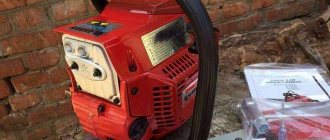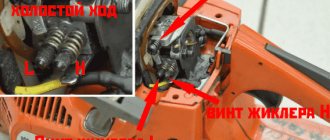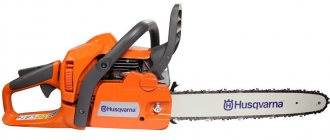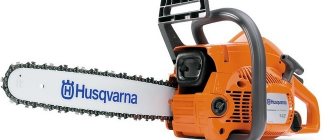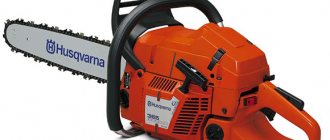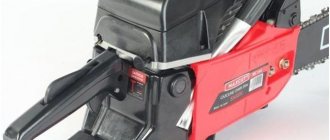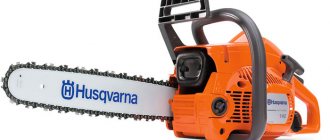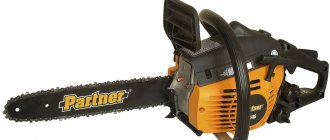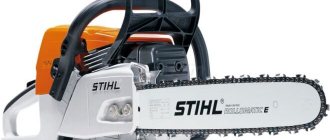Husqvarna chainsaws are indispensable assistants in the household. With the help of gasoline motorized equipment, you can perform various works related to construction, logging and simple trimming of branches. If the tool is handled correctly, it will serve for a long time, but during operation, various malfunctions occur as a result of intense loads.
When minor breakdowns are detected, they do not contact service centers and workshops; routine repairs of Husqvarna chainsaws are carried out independently, and it is necessary to investigate and analyze the probable causes of defects and ways to eliminate them.
Why it won’t start and what to do
Among the malfunctions of the Husqvarna chainsaw are poor engine starting. The engine either cannot be started at all, or it starts poorly.
There is no clear answer to the question why the chainsaw won’t start. The main assembly unit of the tool is the engine. The following conditions affect the stability of operation:
- fuel mixing;
- air;
- presence of a spark;
- lubricant
Each factor is responsible for its own working unit:
- for the fuel mixture - carburetor;
- for air - a cleaning system, in particular an air filter;
- for the spark - the ignition mechanism and spark plug;
- lubrication - lubrication system and gasoline.
A common reason why chainsaws do not start is failure to follow the starting algorithm. The engine unit should only be started after all parts have been completely assembled:
- tires;
- saw chain;
- caps
The chain brake is always on. To avoid losing control of the instrument, you must not start in the air.
Starting the engine in a cold state is done as follows:
- Place the tool on the ground, step on the back handle with your right foot, and place your left hand on the front handle.
- The saw is in a stable state, the chain does not touch the ground.
- With your right hand, take the starter handle and pull the cord, but do not twist it around your hand.
- As soon as the first flash occurs, return the choke lever to its initial position, opening it, and repeat the start.
- They gas it and let it go. The blocking is disabled.
- The engine is switched to idle speed by quickly turning off the gas limiter.
Starting a warm engine is carried out in the same sequence, but without opening the damper.
If the start is made correctly, but the engine does not work, a possible reason is the lack of fuel in the tank, or the carburetor fuel chamber is not filled. Check the tank and chamber, fill them with the mixture.
If the ignition system malfunctions, inspect the spark plug and check for the presence of a spark at the electrodes. If it is wet (gasoline floods the spark plug) and a spark is not detected, the part is turned out, dried or replaced. If it is dry and there is a spark, then there is a problem in the fuel equipment - clogging, depressurization of the gas intake.
See » Review of semi-professional chainsaw Stihl MS 260-16
Magneto malfunctions are also confirmed by a weak spark. Despite the ignition operation, there may be no flash in the cylinder, while the spark plug removed from the cylinder is wet. The solution is to purge the cylinder with the carburetor flaps open.
The electrodes of the system are covered with soot or oily. This can be removed with a wire brush. The spark plug is washed and cleaned by allowing the gasoline to evaporate.
Violation of the gap between the side and central electrodes leads to a poor start. The normal interval is 0.6-0.7 mm. It is adjusted by hemming.
If the ceramic insulator surrounding the central spark plug or the current-carrying core of the wire is damaged, replace it.
If it starts and stalls
The Husqvarna chainsaw starts and stalls when you press the gas. This is caused by a clogged carburetor jet and a dirty fuel tank filter. The defect is eliminated as follows:
- disconnect the fuel hose from the carburetor;
- inspect the fluid leakage - the breather is clean if a full stream comes out.
The next reason why a chainsaw stalls is contamination of the muffler with exhaust resins. The issue can be resolved by cleaning.
Wear of piston rings affects the operation of the cylinder-piston group. If there is play during inspection, parts are replaced.
When starting the engine, the unit may also stall:
- as a result of water entering the mixture;
- due to poor chain lubrication;
- oil wire leakage;
- clogged channels.
Pay attention to the chain:
- if dryness increases, clean the oil supply channels, inspect the elements connecting the fittings to the tubes;
- If there is an oil leak at the connecting points or there are cracks in the tubes, they are sealed with sealant.
The engine does not develop speed:
- if the piston rings burn in the grooves;
- when the crankcase rubber seals wear out and lose elasticity;
- leaks in the connection between the cylinder and the crankcase;
- due to incorrect setting of the ignition timing;
- as a result of contamination of the cylinder fins and fan grille;
- under heavy load immediately after purchasing a new engine.
This is interesting: Ural chainsaw - technical characteristics and adjustment
Model specifications
The Husqvarna brand chainsaw in the proprietary 142 modification has solid factory parameters.
These include:
- petrol engine power – 2.58 liters. s./1.9 kW;
- idle/maximum speed – 3000/13000 rpm;
- The manufacturer's recommended length of the tire used is 30–38 cm;
- weight with filled fuel and oil tanks – 4.9 kg.
Despite the impressive maximum speed parameters, the engine of the Husqvarna model is quite quiet. When operating the model under maximum loads, the sound impact level on the operator is 105 dB.
Business date, meeting
According to its parameters, the saw is designed to solve everyday problems. Thanks to its light weight, compact size and low price, it is ideal for small jobs: cutting firewood, boards, cutting tree branches, cleaning trees and shrubs on the site.
By the way, the chainsaw was in great demand among road workers due to its compactness and reliability. This was ideal for long periods of tree trimming on city streets.
Despite the amateur class, the chainsaw has been and remains very popular among loggers, as it is ideal for small jobs when collecting firewood.
READ Carburetor Adjustment for Husqvarna 128r Lawnmower
Chainsaw delivery set
When ordering the Husqvarna 142 model, the buyer receives absolutely everything necessary to start using and further maintain the garden tool. The model kit includes:
- branded tire and chain;
- plastic tire cover;
- hand tools for assembly and maintenance;
- user manual.
For an additional fee, the manufacturer supplies the chainsaw with a bag for transportation, branded oil for 2-stroke engines and additional spark plugs.
Preparation of fuel mixture for two-stroke engines
Read:
The video shows how to make a fuel mixture for two-stroke engines. Calm chainsaw oil). How much oil to add to chainsaw gasoline? Refueling mowers and chainsaws
And
The use of a catalytic afterburner of exhaust gases, E-TECH technology, reduces their toxicity, is approved for use in all countries and allows us to talk about a qualitative improvement in working conditions. Gasoline for a chainsaw - what kind to pour? How to dilute gasoline for a chainsaw? (Husqvarna). We must pay tribute to the fact that Husgvarna always prioritizes improving the working conditions of its tools. 1959 saw had the lowest noise level compared to other saws, and since 1973, all saws have had an automatic chain brake to protect the saw operator from kickback. Modern chainsaws use a combined chain brake, which stops both manually - by resting your hand on the guard - and automatically, by the force of inertia of the saw's recoil. What oil to use for what oil to pour into gasoline for and husqvarna - for. Many manufacturers, to prevent kickback, eliminate the possibility of working with the toe of the saw and install a limiting shield. But Husqvarna saws do not have it, since Swedish safety standards allow working with the end of the bar. The ratio of gasoline and oil for a chainsaw: how and how to dilute gasoline for a chainsaw? In Russia, only first-class fellers are allowed to work in this way.
In 1969, Husgvarna released a chainsaw with reduced vibration levels and since then its saws have been equipped with anti-vibration systems, the quality of which is gradually improving with the release of each new model. Today, the company installs the LowVib vibration damping system on saws, the principle of which is to balance one mass with another, the inertial interaction of two masses. The chainsaw parts are isolated from the handles by steel springs, and the total mass of the handles is the counterweight. But keep in mind that the quality of vibration damping on household saws is lower, since their operating time is much less than professional saws. It is impossible not to note the double air filtration, which allows you to increase the productivity of the logger and the engine, by reducing the time for servicing the chainsaw. How to properly refuel a chainsaw, prepare what fuel to use. How to dilute gasoline for a chainsaw? The narrow body, high center of gravity and flat bottom make the operation of Husgvarna chainsaws convenient and comfortable.
And the last piece of advice is suitable for all chainsaws, without exception. Don’t forget that according to statistics, approximately 90% of all saw breakdowns are the result of careless handling of the saw set and chain. If the chain is sharpened, then it works, and if not, then it is a person. You put more effort into sawing, increasing the load on the chainsaw, reducing the service life and the entire service life of the unit.
Husqvarna petrol saws are in great demand both among novice gardeners and experienced forest fellers. Models of the Swedish brand have a number of important advantages such as reliability, balance and high working life. Moreover, each Husqvarna chainsaw has a simple design, which makes it easy to maintain and quickly fix any breakdowns that occur.
How and when to adjust the ignition on a Husqvarna saw
Users of Husqvarna chainsaws often have a question: how and when to adjust the ignition. The answer is simple. Husqvarna chainsaws have an electronic ignition coil and flywheel, which do not provide for adjustment. The only thing that can be adjusted is the gap between the coil and the flywheel.
To adjust the gap at home, you need to cut a feeler gauge out of a plastic bottle, and then loosen the screws securing the coil. Next, the probe is installed between the coil contacts and the flywheel. The screws are tightened.
It is necessary to adjust the gap during maintenance or when scoring is detected on the surface of the flywheel. Such scuffs indicate that there is no gap at all.
If, after adjusting the gap between the coil and the flywheel, the parts continue to touch, then it is necessary to check the crankshaft bearings for wear. They may be very worn and require replacement.
This is interesting: Russian-made concrete mixers are popular models
Troubleshooting and DIY repairs
Repairing a Husqvarna chainsaw is complicated by the fact that it requires specific tools that are usually not included in the arsenal of a home craftsman. But all of them can either be bought at an auto parts store or made by yourself.
Chainsaw Husqvarna 142 - technical specifications
In addition to the usual sets of screwdrivers and a hammer, you will need:
- Piston stopper. Can be replaced with a synthetic cord from a starter with knots tied every 2–3 cm.
- Screwdriver for bolt heads on a chainsaw. They can be specific - in the form of semicircles or stars.
- Clutch adjustment key.
- Combination spark plug wrench.
- Compressor for cleaning internal volumes from sawdust, dust and dirt.
If you plan to clean and troubleshoot the cylinder-piston group, you will need a compression measuring device and an adhesive-sealant.
The procedure for disassembling a Husqvarna chainsaw is as follows:
Diagram of a device for checking the ignition of a chainsaw
- the top cover is removed;
- the emergency brake and saw bar with chain are disconnected;
- the starter is removed;
- the candle is unscrewed;
- a piston stopper is installed through the spark plug hole and the flywheel is removed (considerable effort will be required).
After this, the front handle is disconnected, followed by the carburetor, oil pump and lastly the engine.
Troubleshooting the ignition system comes down to replacing failed spark plugs with new ones. Only Champion RCJ7Y spark plugs are used. The ignition coil in Husqvarna chainsaws is electronic, maintenance-free, and if it fails, it is completely replaced, like the starter.
Spark plug Champion RCJ7Y
There is no need to adjust the ignition system. The only problem that can be solved by adjustment is setting the gap between the flywheel and the coil. The gap is set using plumbing gauges. The standard value is 0.2 mm.
Setting up the fuel system
The fuel system of Husqvarna chainsaws is complex. At home, it is better not to repair it, as well as service the cylinder-piston group. The maximum malfunction that can be fixed at home is cleaning the breather, eliminating kinks in the hose and replacing the filter. The same applies to the oil system - troubleshooting comes down to cleaning the hole in the breather with a needle or compressed air. It is recommended to do this preventively every 2–6 months, depending on the intensity of saw work.
Chainsaw Husqvarna 142
Carburetor adjustment
The Husqvarna 142 carburetor has 3 adjusting screws, marked H, L and T. The first is designed to set the injection at maximum speed, the second at low speed, the third determines the fuel injection parameters at idle.
Adjusting the carburetor of the Husqvarna 142 chainsaw
First, the idle injection of the fuel mixture is adjusted by turning screw L ¼ turn counterclockwise. If the saw chain moves, the movement is stopped by clamping the screw T. The adjustment is made with visual and auditory control - the motor should not squeal and white smoke should not come out of it. The correct position of the screw is determined empirically.
After this, the chainsaw accelerator is clamped and the injection at high speeds is adjusted using screw H in exactly the same way.
The leakage of excess air into the carburetor is eliminated by replacing the torn hose - the black tube going to the carburetor, or by fitting it more tightly.
Saw tension
The saw chain tension regulator is on the right side. To access it you will have to remove the side cover. The tension is adjusted by turning the bolt to the required degree.
Video on the topic: Disassembly and assembly of the HUSQVARNA 142 chainsaw
How to set up a chainsaw
In the process of repairing Husqvarna chainsaws with their own hands, they identify some malfunctions that appeared as a result of incorrect ignition adjustments and carburetor settings.
The mechanism is responsible for engine speed and is adjusted for operation taking into account the necessary conditions:
- climate:
- height above sea level;
- petrol;
- loads;
- oil used.
By default, for productive work, the factory settings of the carburetor of the Husqvarna chainsaw are set during testing.
The device has 3 customizable areas:
- “L” - low speed jet;
- “X” - high speed jet;
- “T” - idle speed adjustment screw (XX).
The standard settings are:
- "X" = 11/4 turns;
- "L" = 11/4 turns.
To set up the chainsaw, after break-in, adjust the carburetor: first work with the “L” jet, then with the XX “T” and “X” screws. When “L” and “X” are rotated clockwise, the quality of the working air-fuel mixture deteriorates; when rotated counter-clockwise, it becomes richer. Rotating the screw “T” clockwise increases the idle speed.
See » Advantages and disadvantages of the popular household chainsaw Partner 350
Carburetor repairs are performed by a specialist.
Disassembling the carburetor if necessary to check or repair components
To correctly configure the carburetor of a Chinese chainsaw, you must first remember the factory settings of the device, then turn on the engine. Subsequently, you will have to leave it running for several hours in order to accurately set your own parameters. Sometimes work is carried out only after ten minutes of engine operation, but many Chinese-made models require special handling.
Chinese chainsaw model
Adjustment procedure:
- Activities begin in idle mode. Using the adjusting screws, you need to achieve a systematic increase in engine speed, so you should first let it run at low speeds. A deviation from the norm is the movement of the chain along the bus. In this case, you need to adjust the outer screws to the optimal position so that the chain remains motionless.
- The transition to medium speed speed is carried out. Sometimes the engine starts to smoke. This defect can be eliminated by tightening the screw to supply a leaner fuel mixture.
- The device's engine is being checked. The chainsaw is switched to minimum speed, and then the lever is quickly pressed. When pressed maximally, it is held for 3 seconds. If there are problems with the engine, you need to gradually loosen the screw until the optimal position is reached.
- The chainsaw should work for several hours in real conditions. You need to cut wood, and then inspect all the elements involved in this event. If there are deviations, they must be corrected using adjusting devices. When all defects have been eliminated and the optimal settings have been established to supply correctly concentrated fuel, the device setup process can be considered complete.
Break-in rules
Running in a chainsaw does not last long at XX. Therefore, after starting the engine, you need to idle for about 5 minutes, then start sawing trees with a diameter of no more than 10 cm at medium speed.
The technological process is carried out according to a cyclic scheme:
- 1.5 minutes with minimum load;
- 20 seconds on XX without it.
After operating for the first 25 hours, the unit can reach full power; all rubbing parts are worn in.
During this period, be sure to adhere to the following recommendations:
- do not overheat the power plant;
- do not work for a long time at XX;
- do not load as much as possible;
- suppress long-term slipping of the clutch.
After final running-in, the following work is carried out:
- inspection of the crank mechanism;
- cleaning carbon deposits on all parts;
- checking fasteners;
- assembly;
- preparation of a flammable mixture;
- adjusting the carburetor to maximum power under load.
The saw chain also needs running-in. Attention is paid to its lubrication and tension. The part is tensioned so that it can be rotated freely by hand. Lubrication is carried out by immersion in oil. Then the chain is run at idle for 3-5 minutes. The engine is stopped, the chain cools down and only then the tension is checked.
How to dilute gasoline for a chainsaw
Why does the Shtil 180 chainsaw not start?
How to sharpen a chainsaw chain at home
Which gasoline and oil is better to choose for refueling a Shtil chainsaw: table of ratios, how to dilute, proportions
TOP 2 reliable Hopper chainsaws and owner reviews about modification 4518
TOP 2 high-quality chain saws Tatra Garden (Tatra Garden)
Why is primary adjustment needed?
Initial running-in of the chainsaw: working with thin material
Most modern chainsaws are sold adjusted. However, it doesn’t hurt to check the quality of the factory settings - in the end, it’s you who will have to work with the tool.
When starting up for the first time, the chainsaw should operate in a gentle mode. Therefore, for several hours after start, it is recommended not to overload the engine and cut only small branches and trunks up to 10 cm thick.
Simple rules will help you insure against malfunctions of the chainsaw carburetor:
- Always mix gasoline and oil according to the manufacturer's instructions.
Proportions of the fuel mixture for a chainsaw engine
The chainsaw must start correctly, ensure a stable rotation speed of the sprocket and a smooth increase/decrease in power. There should be no extraneous knocks, pops or noises when the engine is running.
Professional hand chainsaw at work
The main thing during the initial running-in of the tool is to ensure that the fuel consumption corresponds to the power used, i.e. in practice, the saw should not go out, “sneeze”, smoke or run jerkily.
Chainsaw malfunctions and how to fix them
Owners of the Husqvarna 142 model often encounter typical breakdowns caused by improper use of garden tools or simple wear of its parts.
These malfunctions include:
- the chainsaw does not start - the cause of this breakdown lies in the spark plug being flooded. To be able to start the saw motor, you need to remove, wash and dry the spark plug. After this, you need to blow out the cylinder by sharply pulling the starter cable several times with the spark plug turned out. After this, you need to screw in the spark plug and start the engine of the garden tool;
- increased vibration during operation of the saw - repair of this breakdown is carried out by cleaning or replacing the muffler. You will also need to inspect the springs of the anti-vibration system. If necessary, sagging parts must be replaced;
- shooting sounds - if loud popping noises are heard during operation of the Husqvarna model, then the causes of the breakdown should be sought in the carburetor or muffler. The operator will first need to adjust the carburetor. After this, you need to remove and wash the muffler;
- leakage of oil to lubricate the chain - to eliminate this breakdown, you need to check the condition of the oil pump and pipes. The faulty part will need to be replaced.
To avoid further breakdowns of the Husqvarna 142 chainsaw, you need to use high-quality gasoline and oil to refuel it. This will help prevent increased wear of parts and protect model components from overheating.
Adjusting the chain brake
The chain brake often does not work due to grease or sawdust clogging the brake band and the space under the cover. All parts should be cleared of blockages. Perhaps the tape is simply worn out, then it needs to be replaced.
The operation of the chain brake is restored by mechanical cleaning
Some parts of a chainsaw wear out faster than others. These include the drive sprocket, tire, chain, and anti-vibration elements. For quick replacement, it is better to always have spare parts on hand. Don't neglect sharpening the chain.
https://benzopilok.ru/remont/neispravnosti-benzopily-husqvarna.htmlhttps://b-dom64.online/instrumenty/remont-benzopily-huskvarna-137-142-240-365-svoimi-rukami-video.htmlhttps: //diz-cafe.com/tech/remont-benzopily-svoimi-rukami.html
Operational Features
When operating the Husqvarna 142 chainsaw, you need to take into account its features. This is a simplified semi-professional model, not intended for everyday long-term use. The main area of application of the Husqvarna chainsaw is gardening and housing and communal services - pruning large branches, felling dried trees, etc.
The device of the Husqvarna 142 chainsaw
Powerplant - two-stroke carburetor engine with a displacement of 40 cm3
3
and a power of 2.58 liters. s., air-cooled. It runs on a gasoline-oil mixture in a gasoline to oil ratio of 50:1.
During operation, Husqvarna branded oil is required, but if this is not available, the manufacturer allows the use of any high-quality engine oil, but in a different ratio - 33:1.
The Husqvarna chainsaw has a minimum of controls - there is only a switch, a choke position lever and a combined throttle control lever. This model does not have a primer, i.e. a fuel suction button, which makes starting difficult, but makes troubleshooting easier.
Performance qualities allow you to saw dry and wet wood of various species, including hard ones such as oak and beech. In general, the Husqvarna 142 chainsaw is characterized by high build quality, unpretentiousness and reliability. Malfunctions occur rarely and are mainly associated with incorrect carburetor adjustment or failure of consumables.
Advantages of Husqvarna chainsaws
Device
The product has a classic design for products of its class. Manufacturers have embodied simplicity and sufficiency in it.
Construction of the Husqvarna 137 chainsaw:
- frame;
- holding handles;
- mechanical starter;
- internal combustion engine;
- chain brake lever;
- tanks for oil and fuel mixture;
- throttle, gas and choke control levers;
- ignition button;
- muffler;
- sprocket tire;
- saw chain.
The fuel supply system and clutch are mounted inside the housing.
Carburetor
The unit is responsible for supplying a mixture of fuel and oil to the cylinder. The carburetor is equipped with a diaphragm and a special needle valve. These parts regulate the pressure in the system. The dosage of the supplied air is carried out by two dampers located on the diffuser chamber. One regulates the air volume when pressing the gas lever, and the second regulates the flow during a cold start of the tool. At this moment, the damper partially closes, and the enriched mixture enters the engine.
After mixing gasoline and oil, the fuel is supplied to the cylinder through an injector with a check valve. This is an important detail that prevents exhaust gases from entering the diffuser.
Chain
The chain for the Husqvarna 137 chainsaw is different:
- high strength;
- hardness;
- low vibration;
- wear resistance.
The drill links are equipped with chamfers that ensure high-quality cutting of hardwood.
Saw chain characteristics:
- link thickness - 1.3 mm;
- chain pitch - 3/8 inch;
- tire length - 40 cm;
- number of links - 56.
The product uses the “chisel with chamfer” technology. The tension is adjusted with a screwdriver by turning the adjusting screw. Sharpening is carried out with a round needle file with a diameter of 4 mm. An alternative is to use a sharpening machine or the services of specialists from a service center.
Classic layout
The classic Husqvarna layout makes it easy to repair your chainsaw yourself. The set with the saw chain is located on the right and side of the saw, and the emergency brake is also located there. The engine housing is covered from left to right by an auxiliary handle. The on/off button is located at the back and is oriented under the thumb, while the accelerator key is pressed on the handle.
The drum and starter handle are located on the left, above the cooling grille. Bottom left is the fuel tank cap.
All elements of the mechanism are hidden under the case cover.
Layout of Husqvarna 142
Bottom line
Self-repair of Husqvarna chainsaws is only possible if you have at least some knowledge about the operation of a two-stroke engine, as well as the principles on which the chainsaw is designed. As practice shows, it is not difficult to disassemble a Husqvarna chainsaw; it is much more difficult to assemble it without aggravating its malfunction. Calculate your strengths in advance and do not hope that you will be able to repair the saw without some experience. In some cases, even experienced technicians put a lot of effort into correctly diagnosing the problem.
Most common problems
The most common problems with Husqvarna chainsaws include:
Chainsaw ignition system
- incorrectly adjusted carburetor;
- malfunction of the ignition unit;
- fuel unit malfunctions;
- unadjusted clutch mechanism;
- oil system malfunctions;
- Incorrect starter operation.
These problems lead to malfunctions of the chainsaw.
The saw does not start or stalls after pressing the accelerator. Possible causes are a breakdown of the starter (in this case it is not repaired, but replaced with a new one), contamination or breakdown of ignition system elements, faulty spark plugs or coil. The most common faults are spark plugs. Another option is difficulties in supplying fuel; the most likely is a clogged fuel filter or a pinched fuel hose from the tank to the carburetor. The gas tank breather may be clogged.
Difficulty starting, white smoke appears. The cause of these malfunctions is an incorrectly adjusted carburetor, supplying too little or too much fuel mixture, or preparing it in the wrong proportion. A sign of this is white smoke from the engine compartment.
Chainsaw startup sequence
Chain spinning when idling. Causes of the malfunction: unadjusted or failed clutch mechanism, unadjusted idle speed, air leaks into the carburetor or crankcase.
Chainsaw chain device
Saw chain lubrication problems. They are expressed in the absence of lubrication or the chain coming out in a dirty state. The causes of this malfunction are various - a breakdown of the oil pump, blockages in the breather (hole in the oil tank cap), oil channel or filter, or a malfunction of the oil drive gear.
Husqvarna chainsaw chain lubrication system
TOP 5 popular brands
Saving on lubricants leads to accelerated wear of chainsaw parts, and even to its breakdown. We have already noted that under no circumstances should you consume waste liquids - this is a sure step towards destroying your instrument. It is not recommended to fill in diesel oils, spindle and other substitutes. They are not suitable for such purposes and have a bad effect on the performance and durability of the chainsaw.
Husqvarna Chain Oil
Oleo-Mac Polar Lube
The constant use of substitutes accelerates chain and bar wear by 30-40%. When recycling is used, this figure rises to 60-70%. Decide for yourself whether it makes sense to save on oil to lubricate the chainsaw chain.
Recommended chain oils:
- Husqvarna Chain Oil. An excellent solution for working in moderate climate conditions from a well-known manufacturer of garden equipment;
- Oleo-Mac Polar Lube. It has proven itself when working in temperature conditions from -150 to +300 Celsius. Does not pollute the environment;
MANNOL Kettenoel
Liqui Moly Suge-Ketten
STIHL ForestPlus
- MANNOL Kettenoel. It has good adhesive properties, which ensures high-quality chain lubrication. Used at temperatures from - 150C and above;
- Liqui Moly Suge-Ketten. High-quality, multi-purpose mineral oil that reliably protects your chainsaw. Can be used at both high and low temperatures;
- STIHL ForestPlus. An excellent choice for professionals. Will protect your chain well when working in difficult and extreme conditions;
Starter repair
The starter is responsible for starting the unit. Malfunctions indicate the presence of the following malfunctions:
- the spring burst;
- the pulley is damaged;
- The starting cable is damaged.
Sequence of actions for replacing a worn starter cord:
- the starter is disassembled, the mechanism is removed, having first unscrewed the screws securing the housing to the engine crankcase;
- the cord is pulled out at a distance of 30 cm through the hole in the pulley;
- the return spring is set to the neutral position;
- the central screw is unscrewed and the pulley itself is removed;
- a new cord is inserted, tensioned, while 3 turns are wound around the mechanism and secured with a screw;
- the cord is then pulled through a groove in the starter housing and handle.
The return spring is tensioned by rotating 2 turns clockwise, taking into account that it is compressed. When replacing a broken part, the spring should pop out after pulling the inner part down.
